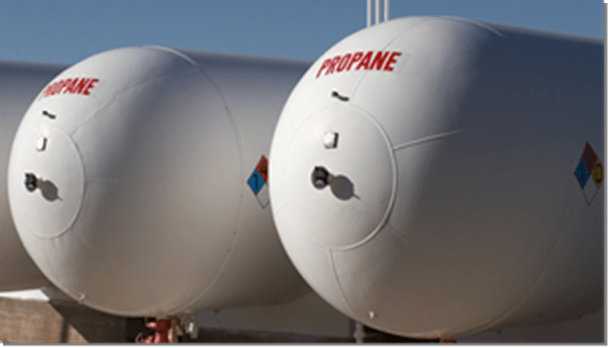Flammables — Propane Dispensing
Propane dispensing stations are found in industrial plants, campgrounds, home improvement stores, service stations, and convenience stores. Proper dispensing of propane protects the safety of operators, the general public, and the surrounding environment. Assure compliance with applicable regulations.

Physical properties of propane:
- Propane is a liquid in its compressed state inside of the cylinder and becomes a gas when pressure is released.
- Propane is colorless and odorless, but an odorant, usually a rotten egg smell, is added to assist in leak detection.
- Compressed propane is very cold and if it comes in contact with your skin or eyes, it will cause burns. Proper personal protective equipment, including gloves and safety glasses resistant to propane, needs to be worn when filling containers.
- Propane is not toxic but if released in a confined space, will displace oxygen. It is heavier than air and will settle in lower areas unless there is significant air movement. Therefore, always assure excellent ventilation.
- Propane is extremely flammable. Sources of ignition are prohibited within 25 feet of the point of transfer. Other combustible materials are prohibited within 10 feet of the point of transfer. Know the location of fire extinguishers and the emergency shut off valve and assure all employees are properly trained.
Inspect cylinders before refilling:
- All cylinders must be manufactured in accordance with industry standard specifications and marked as such. All specifications must be imprinted on the cylinder crown.
- Prior to filling, cylinders must be checked for cracks, bulges, defective valves, dents, or damage to the cylinder valve.
- Assure they are not condemned or past their service date. Cylinders must be requalified or replaced every 5-12 years depending on their condition and their previous requalification method.
- A blue-green stain on the brass portion of the cylinder indicates that it has been in contact with corrosive environments and must not be used.
- Follow all instructions of the supplier and containers being used for propane filling and do not overfill cylinder.

Cylinder marking will show 12-year requalification information and that the cylinder meets DOT specifications.
Cylinder labeling:
- Cylinders used to transport propane must have the proper shipping name and hazard class marked on the side of the cylinder.
Properly utilize propane dispensing equipment:
- Review the propane dispensing instructions of all equipment being used, and assure all employees are properly trained and authorized prior to dispensing work.
- Inspect all valves, piping, transfer hoses, and fittings for proper operation.
- Assure tight fittings between the hoses and containers.
- Assure excellent ventilation and that there are no ignition sources.
- Slowly open liquid outlet valve.
- Report any leaks or problems to supervisor.
- When dispensing is complete, close all valves at the storage tank. Place dust cap or plug in the hose end valve or filling adaptor.
- Store filler hose in proper location.
- Close and lock propane storage cabinet or fence gate.
